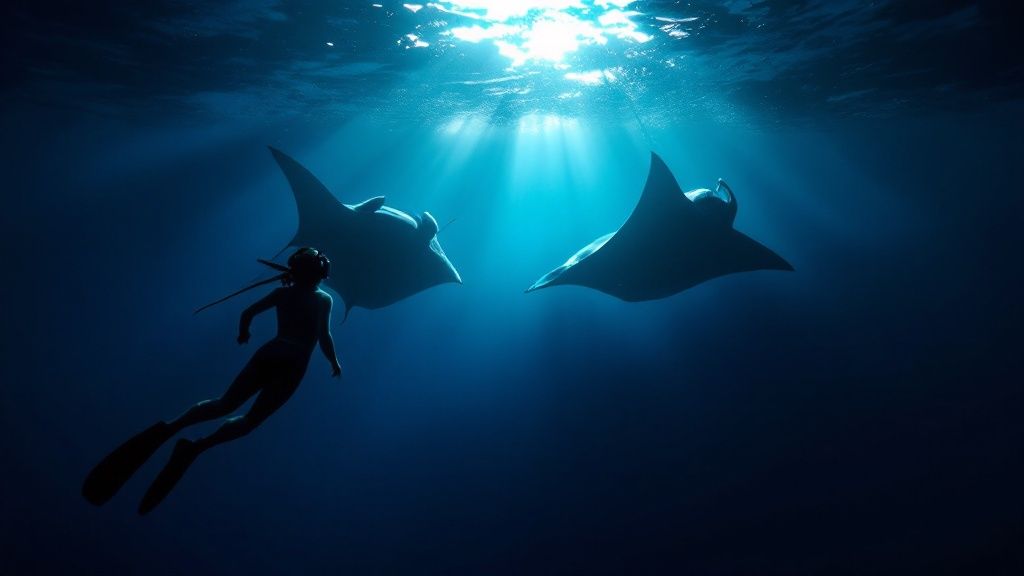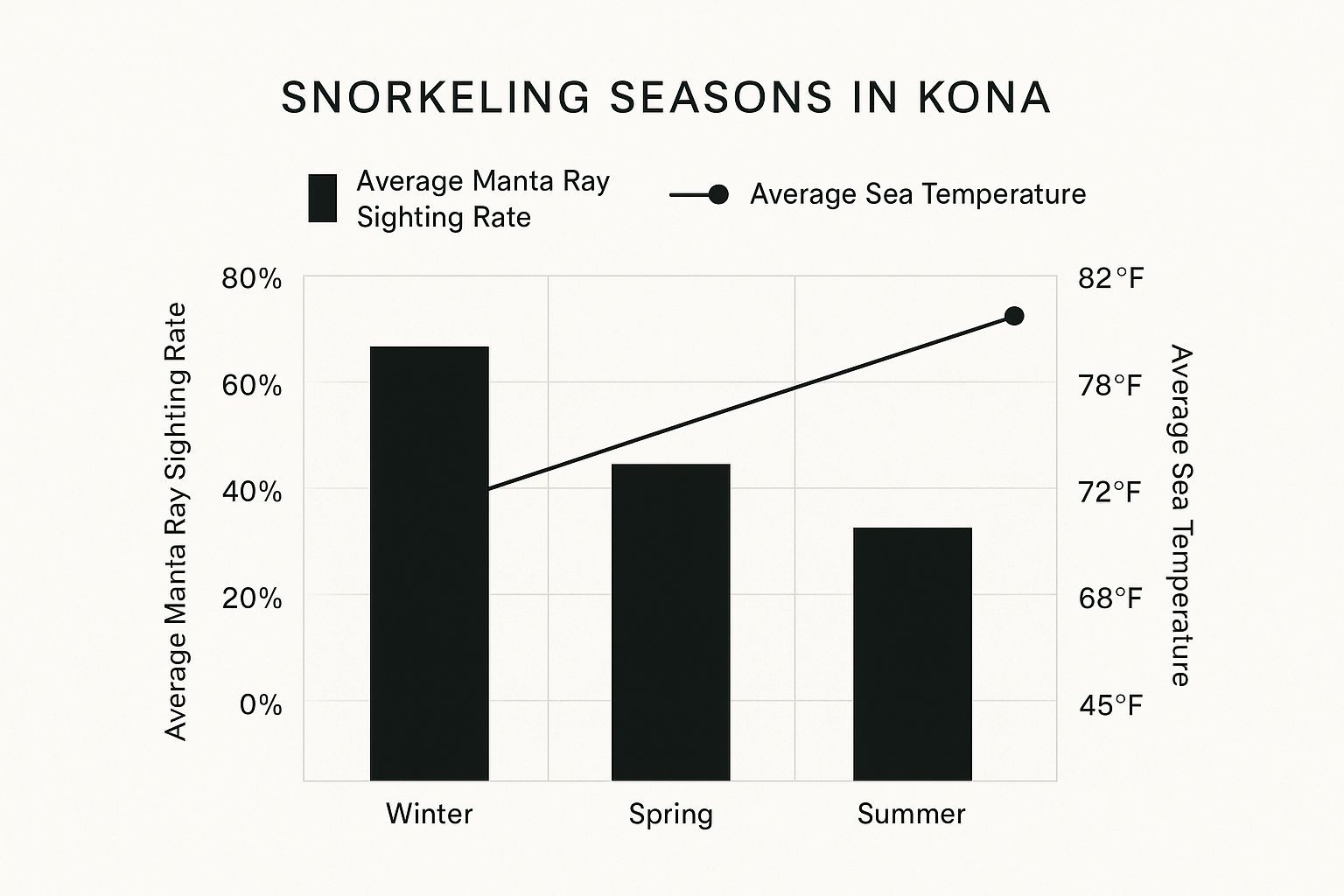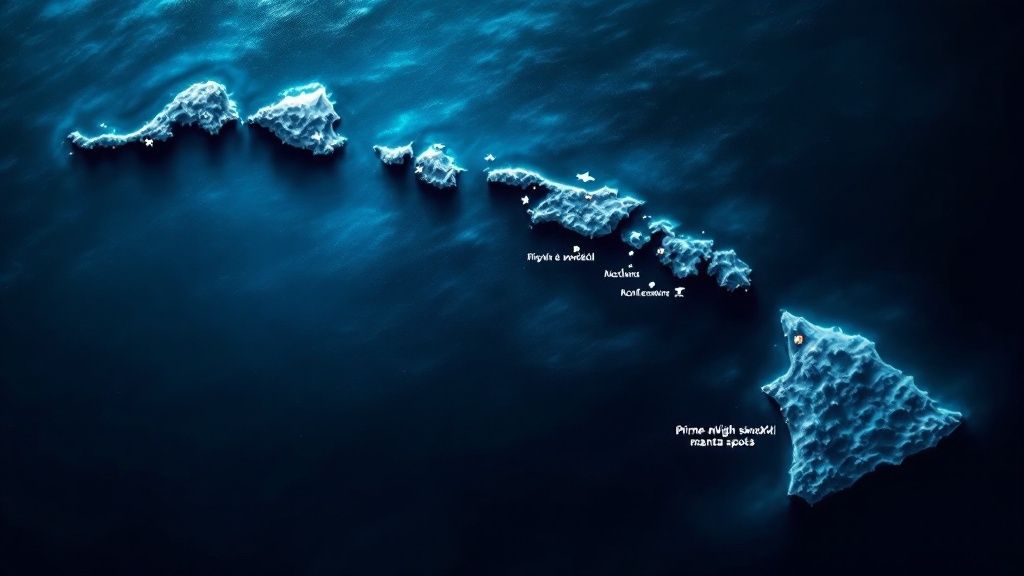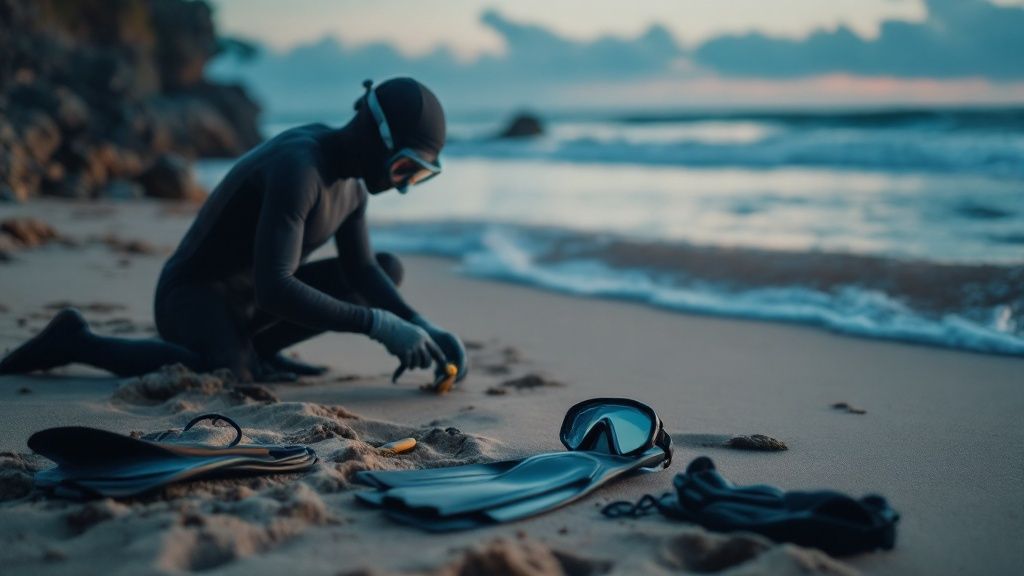Unforgettable Manta Ray Snorkel Kona – Book Your Adventure Today!
- Byron
- May 22
- 12 min read
The Magic of Manta Ray Encounters in Kona Waters
What makes a manta ray snorkel in Kona so special? It's the unique blend of factors that transform a typical snorkel trip into something truly extraordinary. Imagine floating in the dark Pacific, stars twinkling above, when suddenly, huge, graceful shapes emerge from the depths. These gentle giants, with wingspans reaching up to 12 feet, glide through the illuminated water, their movements a captivating ballet. This is the magic of a Kona manta ray encounter.

Kona's distinct underwater landscape and nutrient-rich currents create the perfect environment for these close-up views. The Big Island's volcanic slopes descend sharply, forming deep channels that bring nutrient-rich water close to the shore. This supports thriving plankton populations, the manta rays' main food source. This readily available feast attracts the mantas, providing snorkelers an unparalleled view of their feeding rituals.
Ideal Locations for Manta Ray Sightings
The chosen snorkeling locations are strategically picked for consistent manta ray activity. Keauhou Bay, often called "Manta Village," and Makako Bay, known as "Garden Eel Cove," offer ideal conditions. These spots combine shallow, sandy bottoms, gentle currents, and abundant plankton, enticing mantas to return night after night. Learn more about these amazing creatures: Why Manta Ray Night Snorkel Is the Ultimate Adventure in Kona.
Popularity and Success Rates
The popularity of this activity speaks for itself. Snorkeling with manta rays in Kona has become a world-renowned marine tourism activity, drawing approximately 80,000 participants annually. This high interest stems from the rare chance to observe these creatures in their natural environment, particularly at night. The impressive sighting success rate, between 80% and 90% year-round, further solidifies the reliability of this experience. You can find more detailed statistics from Jack's Diving Locker.
A Transformative Experience
The emotional impact of these encounters is profound. Seeing these magnificent creatures firsthand often creates a lasting memory, shifting perspectives on marine conservation. It fosters a deeper appreciation for the delicate balance of ocean ecosystems. It's more than just sightseeing; it's a truly moving journey.
Prime Locations: Where Manta Magic Happens in Kona
The Kona coast of the Big Island is famous for its incredible manta ray viewing opportunities. These graceful giants gather in specific locations, drawn by the unique underwater environment that Kona offers. Two of the most popular spots for manta ray snorkel kona are Keauhou Bay, often called "Manta Village," and Makako Bay, sometimes referred to as "Garden Eel Cove."
Keauhou Bay: The Heart of Manta Village
Keauhou Bay provides an ideal feeding ground for manta rays. Its shallow, sandy bottom and gentle currents make it easy for them to navigate. The bay's proximity to deeper ocean channels allows nutrient-rich waters, and the plankton they contain, to come close to shore. This abundance of plankton, the manta ray's main food source, attracts these magnificent creatures night after night. This makes Keauhou Bay a reliable location for an unforgettable manta ray encounter. Manta Ray Snorkel tours from Kona Honu Divers offer a great way to experience this unique location.
Makako Bay: A Garden of Delights for Mantas and Snorkelers
Makako Bay shares similar characteristics with Keauhou Bay, offering a shallow, sandy bottom and gentle slope. This creates another haven for plankton, and as a result, manta rays. The bay is also home to a large number of garden eels, adding another layer of interest to this vibrant ecosystem. For more information and tips on snorkeling with manta rays, check out this helpful resource: Manta ray snorkel kona - top tips and best spots.

This infographic provides a visual representation of average manta ray sighting rates and sea temperatures across the three snorkeling seasons in Kona. Sightings remain strong throughout the year, ranging from 45% in Summer to 80% in Winter. Water temperature increases as sighting rates decrease. This indicates that while the warmer summer waters may be more comfortable for some, the cooler winter months offer the highest likelihood of a manta ray encounter.
Choosing Your Ideal Location
The "best" location for your manta ray snorkel kona experience depends on your personal preferences. While both Keauhou Bay and Makako Bay offer fantastic viewing opportunities, there are subtle differences to consider. Manta ray behavior, accessibility, and the overall ambiance can vary between the two. Factors such as crowd levels and the presence of other marine life can also influence your experience.
Think about your comfort level in the water, how you feel about crowds, and whether you prefer a more intimate or more lively snorkeling environment. Researching different tour operators and reading reviews from previous snorkelers can be very helpful in planning your adventure.
To help you choose the best spot for your manta ray experience, take a look at the following table:
To help you choose the right spot for your manta ray adventure, we've compiled a comparison of the main viewing sites in Kona:
Manta Ray Viewing Sites in Kona Comparison of the main manta ray snorkeling locations in Kona, including their features, accessibility, and best times to visit
Location | Also Known As | Best For | Typical Manta Count | Accessibility | Best Time to Visit |
|---|---|---|---|---|---|
Keauhou Bay | Manta Village | Reliable sightings | High | Easy | Year-round, best in Winter |
Makako Bay | Garden Eel Cove | Diverse marine life | Moderate | Easy | Year-round |
This table highlights the key features of both locations. Keauhou Bay, known for its high manta ray count, offers reliable sightings year-round, especially during the winter months. Makako Bay, while having a moderately sized manta population, boasts a more diverse ecosystem, appealing to those interested in seeing a variety of marine life. Both locations are easily accessible, making them suitable for snorkelers of all skill levels.
Day vs. Night: Two Distinct Manta Ray Experiences
Manta ray snorkel kona offers two dramatically different adventures: day and night. Both provide opportunities to observe these graceful creatures, but the behaviors you'll see and the overall atmosphere are distinct. The core difference lies in the manta rays' feeding habits and how they interact with their surroundings.
The Nighttime Spectacle: A Plankton Feast
Nighttime manta ray encounters are truly magical. Under the cover of darkness, specialized lights attract plankton, the manta rays' main food source. This creates a predictable feeding pattern, drawing the mantas close to the surface for breathtaking, up-close viewing. This cascade of light attracting plankton, which in turn attracts mantas, makes for an unforgettable experience. You might be interested in: The Majestic Beauty of Manta Rays: A Night Snorkeling Experience.
This setup allows snorkelers to witness the mantas' feeding dances just inches away. Their slow, deliberate movements as they filter plankton create an awe-inspiring spectacle. It's a unique chance to observe these gentle giants in action, showcasing their remarkable adaptability and feeding strategies.
Daytime Encounters: A More Meditative Experience
Daytime viewing offers a completely different perspective. Without the frenzy of nighttime feeding, daytime provides a quieter, more meditative experience. Natural sunlight offers better visibility, revealing the reef's vibrant colors and the intricate patterns on the manta rays' backs. This enhanced visibility is great for photographers wanting to capture the mantas in their natural habitat. Daytime encounters often occur in different locations than nighttime feeding sites, offering a wider view of the manta rays' habitat and daily life.

Choosing the Right Experience: Factors to Consider
Deciding between a day or night manta ray snorkel kona adventure depends on several factors. Water temperature often differs, with nighttime waters typically cooler. Visibility also varies; daylight offers clearer water, while nighttime lights illuminate the mantas and plankton, creating a unique visual experience. Consider your comfort level in the water, especially at night.
The manta ray snorkeling industry in Kona has grown significantly. Since the mid-2000s, particularly after regulated night snorkeling tours began tracking sightings in 2009, the industry has boomed, attracting approximately 80,000 snorkelers annually. This surge has benefited local tourism and contributed to global manta ray conservation efforts. Learn more about Kona manta ray tourism. The best choice depends on your preferences and the type of encounter you're looking for.
Selecting Your Perfect Manta Ray Tour Experience
Ready for an unforgettable manta ray snorkel Kona adventure? With so many tour operators to choose from, finding the perfect fit can feel overwhelming. Let's break down the key factors to consider so you can make an informed decision and create truly special memories.
Group Size: Intimacy vs. Crowd
The size of your tour group can dramatically impact your manta ray experience. Larger groups (often the more budget-friendly option) can feel a bit crowded, especially once everyone's in the water. This might mean less one-on-one time with your guides and potentially obstructed views of the mantas. Smaller groups, on the other hand, create a more intimate setting, fostering more interaction with guides and providing better chances for close-up encounters with these gentle giants.
Boat Design: Comfort and Speed
The type of boat also matters. Some tours utilize larger, more stable vessels. These offer a comfortable ride but may require a longer transit time to the snorkel site. Smaller, faster boats can get you to the action quicker, minimizing your time exposed to the elements after your snorkel. This is especially beneficial for night tours when the air is cooler. Consider your comfort level and potential for seasickness when choosing.
Equipment: Essential Gear for a Great Experience
While most operators provide basic snorkel gear, quality can vary. A well-fitting wetsuit, even in Kona's typically warm waters, is essential for night snorkeling, as the water temperature can drop significantly after sunset. A 3mm wetsuit offers a good balance of warmth and flexibility. A well-fitting mask and anti-fog solution are also crucial for clear underwater vision. Some tours offer flotation aids, which can be helpful for less confident swimmers or those looking to conserve energy.
Budget vs. Premium: Finding the Right Balance
Budget-friendly tours offer a more accessible way to experience the magic of manta rays. These typically involve larger groups and more basic amenities. Premium tours, while more expensive, generally feature smaller groups, high-quality equipment, and more personalized service. Think about your budget and which aspects of the experience are most important to you. For more tips, check out this guide on planning your ultimate manta ray encounter.
Accessibility: Tours for Everyone
If you're traveling with family, seniors, or individuals with limited swimming experience, choosing an accessible tour is essential. Look for operators with experienced guides who are comfortable working with people of different abilities. Some tours offer extra support, such as flotation devices and individual attention, to ensure everyone has a safe and enjoyable experience.
To help you compare different tour options and make the best choice, take a look at the table below:
Manta Ray Snorkel Tour Comparison: Detailed comparison of tour types, typical inclusions, group sizes, and price ranges to help readers select the right tour
Tour Type | Group Size | Duration | Typical Inclusions | Price Range | Best For |
|---|---|---|---|---|---|
Budget Tour | 10-20 | 1-2 hours | Basic snorkel gear, wetsuit | $90-$150 | Budget-conscious travelers, larger groups |
Standard Tour | 6-10 | 1.5-2.5 hours | High-quality gear, snacks | $150-$250 | Balanced experience, smaller groups |
Premium/Private | 2-6 | 2-3 hours | Personalized service, additional amenities | $250+ | Families, private groups, enhanced experience |
This table summarizes key differences between the various tours, making it easier to pick the manta ray snorkel Kona adventure that best suits your needs and budget. Remember to consider your personal preferences and desired level of comfort when making your final decision.
The Science Behind Sustainable Manta Encounters

The thriving manta ray snorkel Kona industry demonstrates a remarkable harmony between tourism and conservation. This balance is maintained through scientific research, partnerships with tour operators, and responsible viewing practices.
Identifying Individual Manta Rays
Each manta ray has a unique ventral spot pattern, much like a human fingerprint. Marine biologists use these patterns to track individual mantas over decades. This allows them to gather important data about their life cycles, migration patterns, and population dynamics.
This long-term tracking helps researchers understand how these animals interact with their environment and how tourism affects them.
Data Collection and Research
Kona tour operators actively participate in data collection. They work with scientists, sharing observations and photographs from each manta ray snorkel Kona excursion.
This steady stream of information contributes to one of the world's most complete manta ray datasets. For example, detailed annual statistics on manta ray sightings along the Kona Coast have been gathered since 2009. This provides valuable insights into population trends and behaviors. You can find more detailed statistics here.
Shaping Viewing Protocols
The research directly shapes the viewing protocols used during manta ray encounters. These protocols are designed to minimize stress on the mantas while still providing a great experience for visitors.
Guidelines cover boat positioning, light usage, and snorkeler behavior, ensuring respectful interactions that protect the mantas and their habitat. Research indicates that sightings occur in about 85-90% of guided snorkeling excursions.
Conservation Initiatives
By joining a manta ray snorkel Kona tour, you directly contribute to these important conservation efforts. The revenue supports ongoing research and helps protect these magnificent creatures.
The data collected also provides valuable insights into the challenges facing manta ray populations worldwide. For example, movement pattern studies reveal that individual manta rays can travel incredible distances. Loulou Ray swam 42 miles over eight weeks, while Jolene Ray covered the same distance in just eight days. These findings emphasize the dynamic nature of these animals and the importance of understanding their needs.
Preparing For Your Manta Ray Adventure Like a Pro
What separates a so-so manta ray snorkel Kona experience from a truly unforgettable one? Preparation. Using advice from experienced guides and countless visitor reviews, this guide outlines practical steps to maximize your comfort and enjoyment.
Gearing Up For Success: What To Wear
Knowing what to wear, both on the boat and in the water, is crucial for a comfortable experience. While tour operators offer suggestions, these insider tips can significantly improve your time on the water. A 3mm wetsuit offers warmth and flexibility for nighttime snorkeling. While Kona waters are usually warm, the temperature can dip after sunset. For the boat ride, layers are essential. A light jacket or windbreaker will keep you cozy on the trip to and from the snorkel site.
On the Boat: Layers are key! Consider a light jacket, comfortable pants, and easily removable shoes.
In the Water: A well-fitting 3mm wetsuit is highly recommended, even in warmer months. This provides warmth and protection against potential stings from marine life.
Seasickness Strategies: Preventing Discomfort
For some, seasickness can dampen any ocean adventure. However, some proven strategies can help prevent nausea before it starts. Consider taking motion sickness medication an hour before your tour. Acupressure wristbands are a drug-free option that many find effective. Staying hydrated and avoiding heavy meals before the trip can also minimize nausea.
Medication: Over-the-counter motion sickness pills can be very helpful.
Acupressure: Wristbands applying pressure to specific acupressure points can offer relief without medication.
Hydration and Diet: Staying hydrated and having light meals can help prevent queasiness.
Essential Extras: Small Items, Big Impact
Experienced snorkelers understand the importance of small items that enhance comfort and enjoyment. A small waterproof bag can protect your phone, keys, and other valuables. A microfiber towel is perfect for drying off after snorkeling. And don't forget a reusable water bottle to stay hydrated.
Waterproof Bag: Protect your valuables from splashes and unexpected submersion.
Microfiber Towel: Lightweight and quick-drying – ideal for boat trips.
Reusable Water Bottle: Stay hydrated throughout your adventure.
Mastering Your Snorkel Gear: Tips For Nighttime Success
Even for snorkeling novices, mastering your gear in nighttime conditions is crucial. Ensure your mask fits snugly and is treated with anti-fog solution. This is especially important in the dark. Remember, getting in the water is your choice. There's no shame in requesting a life vest if you don't feel confident. Practice breathing calmly through your snorkel and relax in the current. Relaxing helps you stay warmer and enjoy yourself. Read also: How to master your Manta Ray Night Snorkel in Kona.
Mask Fit: A proper fit prevents leaks and maintains clear vision.
Anti-Fog: Use anti-fog solution to ensure clear underwater views.
Breathing: Practice slow, deep breaths through your snorkel for relaxation and to prevent hyperventilation.
Capturing The Magic: Photography Tips
To capture stunning manta ray photos, a few adjustments will make a significant difference. Increase your camera's ISO for low light and consider a red filter to enhance underwater colors. Positioning yourself for clear shots without disturbing the manta rays is also crucial. Respectful distance ensures both great photos and minimal disruption to these gentle giants.
High ISO: Adjust your camera for clear images in low light.
Red Filter: A red filter on your camera lens will enhance underwater colors.
Respectful Distance: Maintain a safe and respectful distance while taking photos.
By following these pro tips, you'll be ready for a genuinely magical manta ray snorkel Kona adventure. Thoughtful preparation increases your comfort and enjoyment, and ensures a respectful and sustainable experience for these magnificent creatures.
Your Manta Ray Journey: From Shore to Unforgettable Encounter
Your manta ray snorkel Kona adventure begins long before you dip your toes in the water. From the moment you step into the tour office, the excitement for this unique experience starts to build. This guide walks you through the journey, preparing you for every step.
Check-In and Briefing: Getting Started
Your adventure kicks off with check-in and a comprehensive safety briefing. This covers essential information about the snorkel site, manta ray behavior, and responsible viewing practices. Before heading out, it’s crucial to double-check your equipment, much like a drone pre-flight checklist, to ensure a smooth and safe experience for both you and the manta rays. Experienced guides are available to answer any questions and calm any pre-snorkel nerves.
Boat Ride to the Snorkel Site: Scenic Transition
Next, you'll board the boat for a scenic ride to the snorkel site, either Keauhou Bay (Manta Village) or Makako Bay (Garden Eel Cove). As the sun dips below the horizon, painting the Pacific in warm hues, the anticipation grows. The boat ride offers breathtaking views of the Kona coastline. Those on the sunset tour might even be lucky enough to spot whales.
Entering the Water: The Magic Begins
At the snorkel site, the guides will assist you in entering the water and getting comfortable with your gear. As darkness envelops the ocean, specialized lights are strategically placed to attract plankton, the key ingredient to this magical experience.
Manta Ray Arrival: A Breathtaking Spectacle
The plankton creates a feast, drawing manta rays from the depths. Shadowy figures begin to emerge, their graceful movements captivating. Guides will position you for the best possible views, ensuring minimal disruption to the mantas’ feeding. These gentle giants, with wingspans reaching up to 12 feet, will glide effortlessly just below you, creating a truly awe-inspiring spectacle.
The Return Trip: Reflecting on the Experience
As the snorkel session ends, you'll return to the boat, filled with the wonder of your close encounter. The return trip is a perfect time to share stories with fellow snorkelers, reflect on the experience, and appreciate the delicate ocean ecosystem. Many tours offer light refreshments to warm you up after your time in the water.
Practical Considerations: Tipping and Restrooms
Keep in mind that restroom facilities on smaller boats are often limited. It's best to use the restroom before departing from shore. Tipping your guides is customary to show appreciation for their expertise and service. While there's no fixed amount, 15-20% of the tour price is a good guideline.
Ready for this magical encounter? Book your unforgettable adventure with Manta Ray Night Snorkel Kona Hawaii Tours today!
Comments